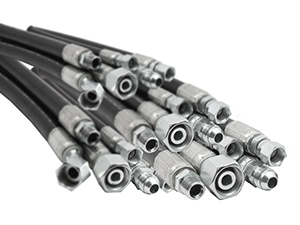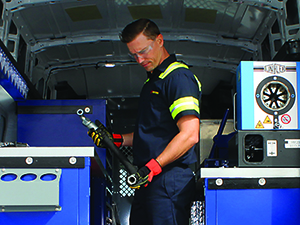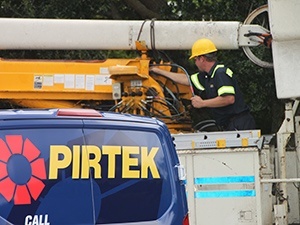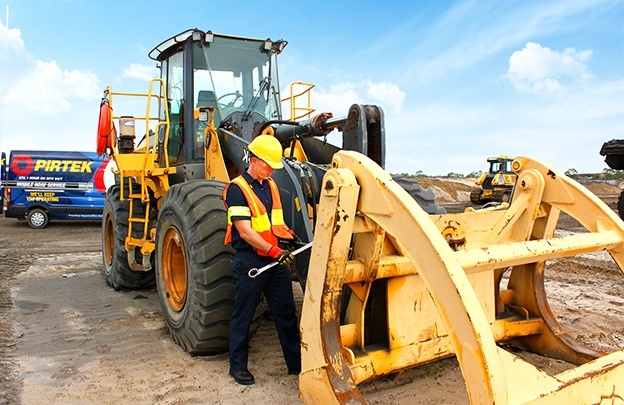Hydraulic hose and industrial hose failures cost businesses around the world tons of revenue every year. Production shortfalls and environmental cleanup costs can cripple a company’s bottom line. Also, missed deadlines can ultimately make a company look unreliable.
Most importantly, faulty hoses cause issues and hazards that can injure on-site workers. When a hose ruptures under high pressure, it can whip around injuring everything and everyone in its path. In addition, a brittle hose or an improper fitting can leak fluids creating slip and fall accidents.
Because of these problems proactive care of hydraulic hoses and fittings is absolutely crucial to your business. The responsible business owner will take measures to prevent mechanical failures and employee injuries before they happen. This approach is smarter than reacting to the problematic situation after it’s too late.
Regular hydraulic hose and industrial hose maintenance can save your business reputation and bottom line. The information in this article will help keep your equipment operating at its best. Read on for an outline of areas of care and maintenance for hydraulic hoses and industrial hoses.
5 Cost Effective Ways To Maintenance Your Hoses
A hydraulic, industrial, or fluid transfer system contains pumps, valves, pipework, and actuators. The system creates energy by controlling the force of the compressed liquid. Different machines harness this force in many ways to power their moving parts.
Countless industries rely on hydraulic powered machines to complete their daily operations:
- Barges
- Boilers
- Construction Equipment
- Drilling rigs
- Earthmovers
- Ocean Liners
- Semi-trucks
- and many more…
In addition, lighter applications such as transmission and steering lines also use hydraulic power. Each of these also rely on hydraulic systems to keep them working.
All these systems are at the mercy of its hoses and fittings down the entire line. If one hose or connection fails, the whole machine fails. Every industry shares a common problem when it comes to hydraulics… When a piece of equipment breaks, production comes to a screeching halt.
Frequent Inspection of Hose and Fittings

Inspect your hydraulic hoses and fittings every 600 hours of use – or every 3 months. Adjust this schedule according to the specific setting the hose is in. Some factors that affect hose life are:
- Impulse cycles
- Temperature
- Pressures
- Working environment
Take each of these items into account. Sometimes it’s necessary to schedule inspections at more frequent intervals.
To inspect hydraulic hoses in a safe manner the equipment must be locked out and tagged out. Also, take every precaution against accidental startups. Remove keys from the ignition and give the machine time to cool down before beginning.
Perform a visual inspection of hydraulic hoses and look for any signs of aging such as:
- Cracks
- Splits
- Cover missing
- Exposed reinforcement
- Abrasions
- Blisters
- Missing or broken clamps
- Other obvious signs of wear
Take note of the position of the hoses: They must have enough slack to account for movement during use. Kinks or twists in the hoses can decrease efficiency and cause them to wear out faster. Hoses should not rub against each other, or any machine parts during operation. This friction can cause premature ruptures.
Between scheduled maintenance checks, operators should remain vigilant about hose safety. Each workday should begin with a quick scan of hoses and connections. Workers should look for:
- Drips
- Puddles of fluid on the ground
- Frayed hoses
- Dampness behind the ferrule
Operators also need to pay attention to how their machines behave while they are running. No one knows a machine better than the person who uses it every day. These are often the first to notice a problem. If a machine sounds odd or is sluggish to respond to controls, for example. This is cause for concern and the machine needs to have an inspection as soon as possible.
Maintenance Logs

Keeping records of your hydraulic hoses and industrial hoses is important. Record-keeping goes hand in hand with the inspection process. Logs of inspection results, repairs, and hose replacements allow for proactive care.
Inspectors should be able to open a maintenance log and know which hoses are the oldest. They should also be able to see which hoses need closer monitoring than others. This information can then be used to give extra attention to the older hoses and fittings.
One way to simplify the inspection process is to use hose tags. These tags are applied to each hose when it is assembled. A serial number with barcode on the tag is linked to the hose assembly’s unique Bill of Materials, related manufacturing information, test reports, and all other asset information required. A hose tagging system is an accurate method for tracking hose performance and cycle life.
There are other reasons why record keeping is important. For example, the life of a hose is often measured by the number of times the system cycles. All hose manufacturers place a limit on the life of their hydraulic hoses and industrial hoses.
It’s vital to know which hoses on a piece of equipment are nearing the end of their recommended use. However, this information is not always made clear by a date marked on a calendar. Most businesses experience fluctuations throughout the year related to other variables. The following variables make it more difficult to pinpoint when a hose will reach the end of its life:
- Productivity
- Operating hours
- Workload
- Number of impulse cycles
- Number of machines in operation
Hose and Fittings Selection

There are many factors to consider when choosing the right hydraulic hose or industrial hose solution. If any condition is incorrect the assembly will not operate to its full capacity. It’s more likely to wear out sooner than if the correct parts were used. The best solution for the job may be more expensive, but it will pay for itself in the long run. This will save you time, money, and headaches.
The hose you choose must be compatible with the substance used within the system. There are many different types of substances conveyed by hoses in an industrial setting:
- Air
- Fuels
- Gases
- Mineral oils / Vegetable oils
- Refrigerants
- Water
- and more…
Each of the above substances interact with hose materials in its own way. Hydraulic hoses have a chemical compatibility rating that reflects the type of fluid or gas it should be used with.
In addition, the hose size depends on the volume of liquid or gas that will travel through it. The hose size must be capable of meeting the capacity of your hydraulic system.
While it’s important to keep parts compact, don’t go so far you sacrifice system pressure. A hose that is too small can restrict flow and increase temperature. Keep in mind, the hose must meet your system requirements for pressure, velocity, and temperature.
One of the most important factors for your hose is the type of work it will do. Along with this is the type of setting it will be used in. The list of industries that rely on hydraulic systems and their parts is staggering. Manufacturers have adapted hoses and materials for each type of situation.
Some types of heavy equipment call for hydraulic hoses that are extra rugged:
- Skid steers
- Earthmovers
- Excavators
- Forklifts
- Cranes
- Scrapers
- Dump trucks
- and more…
Earthmovers and heavy equipment work in harsh environments. Construction sites and similar zones can be hazardous for the hoses on these machines. An exposed hose can get smashed, severed, or pulled off by objects around a job site. Sharp pieces of steel, concrete, or rebar are usually prevalent and can cause a lot of this damage. Hoses like these need more protection in the form of textile, metal, or plastic sleeves.
Other uses for hydraulic and industrial hoses include less aggressive environments. Less protection on tubing can be used in these settings:
- Oil cooler systems
- Power steering systems
- Lubrication systems
- Pressure washing systems
Even in less severe environments, it’s vital to match the correct hydraulic hose to the job. For example, marine use can damage hoses in a short time. This setting exposes the hoses to a broad spectrum of corrosive elements. They have to stand up to sunlight, saltwater, and moisture.
When performing hydraulic hose replacement, temperature plays an important role. Heat or chill of materials moving through the hose must match the performance of the hose. It’s normal to first think of the highest temperature that your equipment can handle. Then make sure the hose can handle the high heat.
It’s also important the hose matches the lowest operating temperature as well. Some types of hoses are not ideal for use at lower temperatures and will lose their flexibility.
Also consider hydraulic hose accessories such as:
- Adapters
- Fittings
- Couplings
- Connectors
- Clamps
These items are key to getting hoses to fit well. There must be a proper connection when it comes to replacing hydraulic lines.
A quality hydraulic hose inspection includes checking that fittings and hoses are compatible. This doesn’t always mean they must all be the same brand. It’s usually considered best practice that they are, but it’s not required. When fittings and hoses are of a different make, check with the manufacturers. They can inform you whether the components will work together or not.
Hose and Fittings Installation

Once you’ve chosen the right hydraulic or industrial hoses and fittings for your machine, installing them correctly is the next step and a very important one. Improper installation can lead to bigger headaches and more expense unexpectedly later on. There are three key parts of the installation process to follow for a proper install to go well:
1. Hose Length
Take new measurements and measure again for accuracy. When replacing a hydraulic hose or industrial hose, you can’t rely on the length of the old hose to make a copy. Be sure to account for the space needed at either end for fittings and couplings. A good installer knows how much hose each type of hydraulic accessory will need. The hose length must also allow for movements during operation. There should be no kinks in the hose once it’s threaded through the machine.
2. Hose Cutting
Once you’ve measured the new hydraulic hose, it’s time to cut it to length. This simple task can cause huge problems if done wrong. You must use specialized cutting equipment with matching blades. They must match the type of hose that is being cut. It takes considerable skill to ensure the hose end isn’t slanted after cutting. This can make it leak once installed. Take great care to avoid any debris or particles from entering the hose line.
3. Hose Cleaning
When a hydraulic hose is cut with saws that use metal blades or abrasive wheels a tremendous amount of heat is generated. The heat from the cutting process will cause the rubber dust and metal particle contaminants to stick to the hose tube as they cool.
Make sure new hoses are free of debris by firing special foam pellets through the hydraulic hose prior to installation or capping. A hose cleaning system such as this can reduce system contamination and improve performance.
4. Hose Positioning
Attention to detail is very important here. The fittings should align in a way that complements one another. Never exceed the bend radius of the hose being installed. The installer must use the proper guidelines for installation::
- Orientation
- Correct use of adapters
- Accommodation of movement
- Clamps
The proper tools and technique can help ensure the right fit. Proper clamps used in specific situations can help keep hoses out of harm’s way. Be careful not to run hoses too close to heat sources or the moving parts of the machine.
Preventing System Contamination

Small pieces of debris can pollute hydraulic systems during hose changes. A speck of dust or small piece of hose material can be a threat to a huge piece of heavy equipment. Small fragments may not be large enough for the filtration system to catch. However, these small particles are still large enough to create an abrasion of the hose’s inner lining. Under high pressure, they destroy hoses from the inside out.
Also, when replacing hydraulic hoses, there are other ways system contamination could occur. It could happen while the system is open during the filling of oil or other liquids. As machinery ages, it starts to break down. Corroded pieces of components may make their way into the system.
An easy way to reduce this threat is by following the manufacturer’s instructions. They guide the life cycle of components and let you know when to change oil and filters. It’s smart to take regular oil samples to track the particle count. This is a reading of how many small bits of material are in the fluid. The reading can identify problems, and help technicians keep the hydraulic system clean.
Some settings may call for an extra filter within the hydraulic system itself. This can help maintain a low particle count in situations like dust filled mining or excavating.
Conclusion
Preventative care for hydraulic hoses and industrial hoses may seem expensive and tedious. A maintenance program like the one offered by PIRTEK Service & Supply Centers will pay for itself in the long run. Proper care of hydraulic systems will help prevent:
- Costly equipment downtime
- Employee injuries
- Environmental hazards
- Loss of employee wages
- Headaches
Sources

The hydraulic hose and industrial hose experts at PIRTEK USA



